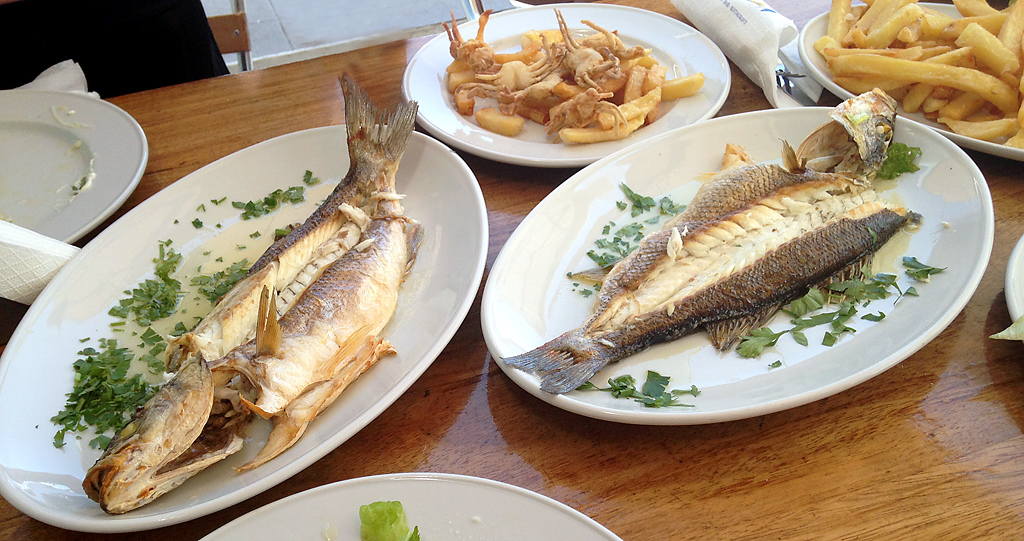Cypriot sweets. Cypriot sweets made from grapes. Fish dishes and snacks
I continue my story about our excursion from VK. I talked about the cheese factory. Today we will talk about traditional Cypriot sweets, and specifically about Cypriot kozinaki. They differ from Russian ones in that they are made from large quantities of sesame and nuts, rather than sunflower seeds. There are pastilles made only from sesame, and some made from sesame and nuts. Nuts are mainly peanuts or almonds, less often pistachios and pumpkin seeds. Sugar or carob syrup is used for gluing (I will definitely tell you what it is in the next posts), but honey is more often used. Honey in Cyprus is specific, not as fragrant as in Russia. It's more like sugar syrup with honey flavor in my opinion. Our favorite lozenges are the pistachio ones from Nutcracker.
When we arrived at the “sweet” factory, the machine for producing pastilles was already in full operation. It was heated up, nuts were swirling and roasting there, and a kind uncle carefully placed honey there, spoon by spoon.
These will be pastilles made from three ingredients: sesame, peanuts and honey. 
While the sweets were being prepared, I decided to wander around the factory. This is more likely not a factory, but a large hangar with production and storage of products in one place. Nuts are stored in large buckets. 
Or in bags, like my favorite pecans. 
And these are units for the production of pastillacs, but only bigger size, so to speak in industrial scale. They showed us everything when we were little. 
They are large rotating metal bowls. 

After the pastillas are prepared, they are laid out on these tables for compaction. 
And this is juk-juk. In our opinion, churchkhela is nuts in boiled grape juice. You can watch a wonderful story about their production. 

This is a ready-made juk-juk, waiting to be bought. =) 
Meanwhile, our “test kozinak” is almost ready. The hot honey-nut mass was first poured into a copper basin, and then onto a special rectangular mold. 

Where they began to compact the mass with spatulas and then with a rolling pin. 

It is necessary to compact it firmly so that when the honey hardens, it glues the nut components together and the lozenges become a single whole and do not fall apart and crumble. 
Next, the mold is covered with a lid with parallel slits. 
Through which a large kozinak is first cut lengthwise into equal rectangular parts. 
And then across. 
These are the smooth squares we ended up with. 
Then the pastilles are transferred to the table to cool. 
They cool quickly, about 5 minutes. 
While the sweets were cooling, we were shown how the nuts were roasted in a special oven. 
Before placing the nuts in the oven, it must be thoroughly heated. Meanwhile, the nuts are soaked in concentrated salt syrup 
And only then they are put into the oven. The salt sets there and forms a salt crust on the nut. 
After viewing and gaining knowledge, there was a tasting and purchase of products. Oh, I couldn’t resist and devoured as many as 3 squares of pastillac. Fresh, piping hot.
Among the products of Cyprus, which can sometimes be found on the shelves of Russian stores, you are unlikely to see Cypriot sweets. Most likely, these will be Cypriot wines, the popular Cypriot Muscat with a bare-bellied baby on the label, and halloumi cheese. But even if you have never been to Cyprus, it is possible that you have encountered something very similar to Cypriot sweets. Their main difference: a minimum of chemicals, a maximum of natural products.
Let's start with a very common one: uzhukos, or sujukos. This is grape juice boiled until thick with a small amount of flour. While the juice is being boiled and evaporated, they are strung on a harsh thread like beads almonds. The nuts are dipped in grape juice several times, each time before the next immersion they are dried in the shade in the breeze. As a result, after 5-6 days you get almost Georgian churchkhela.

In the next photo there is a block similar to laundry soap, the same evaporated grape juice with the addition of rose water, only without nuts, called. By the way, rose water is widely used in making various sweets and for impregnating puff pastry products.

A classic oriental sweet with a 500-year history. Made from starch or gelatin, sugar and fruit juices, sometimes with the addition of almonds or other nuts.

In my opinion, the most delicious Turkish delight is made by one family in the village of Fini. Sometimes Turkish delight produced in Fini, if you’re very lucky, can be found in a supermarket, but it’s better to buy it in the village itself, straight from the heat. Turkish delight in Fini is made in two versions: with and without almonds. This delight has a distinct bergamot scent. Bergamot is a citrus, a close relative of oranges and lemons, with a very strong aroma. Earl Gray tea owes its specific smell to bergamot. (By the way, “Earl Grey” is translated into Russian as “Count Grey”. Gray is a surname. That is, this is not a gray count, as English “experts” often translate the name of tea. Sorry, I couldn’t resist, I was boring. This is from sore) So, if you love Turkish delight and you like Earl Gray tea, you can safely buy Turkish delight from Fini. You will not regret. On September 12, 2012, if you buy it in Fini, it cost 3 euros without almonds and 3.50 with almonds for a box weighing 500g.


The whole family pastelaki is closely related to the Kozinaki. This is sesame or a mixture of peanuts and sesame, "cemented" with a honey-based syrup. Simply nuts glazed with honey syrup are also very popular in Cyprus.
Many of us, when traveling to a country for the first time, are interested in its cuisine and gastronomic traditions. This is not surprising, since tasteless food can ruin your entire vacation. But rest assured that this will not happen to you in Cyprus, and if you manage to get out of the hotel and go to a traditional tavern located somewhere in a remote Cypriot village, then wonderful memories of the cuisine of Cyprus will remain in your memory for a long time.


By its nature, the cuisine of Cyprus is a kind of kaleidoscope. Some believe that it almost completely reflects Greek traditions, but this is not entirely true. Since Cyprus was for a long time under the rule of a wide variety of conquerors, they introduced their own characteristics into the customs of the local residents and formed new traditions.
In addition, the island has always been a favorite destination for foreigners, and this is also reflected in Cypriot cuisine. Greeks and Turks, Armenians and Lebanese, Italians and French have all contributed to the diversity of Cypriot cuisine. Let's add to this the fact that generous nature gives the island a large number of natural products. All this explains why Cyprus is a kind of paradise for gourmets from all over the world.
As the Cypriots themselves believe, their cuisine is based on three pillars:

Probably, someone will be surprised that, although there are a lot of excellent foods in Cyprus, seafood came into use relatively recently. This is explained, in particular, by the fact that in the old days, most local residents, fleeing the attacks of pirates and invaders, lived in mountain villages at a fairly large distance from the sea.
One can also note this feature of Cypriot cuisine: they use much less fat for cooking than most of their Mediterranean neighbors, which is quite consistent with the principles healthy eating. Unless, of course, we are talking about sweets heavily soaked in honey.
Snacks and salads in Cyprus
 Greek cuisine predominates among traditional appetizers and salads. These include taramasalata (a pink, creamy fish roe appetizer) and tzatziki – chilled yogurt with finely chopped cucumbers, mint and garlic. Cypriots can simply spread them on fresh bread or use them as sauces. Sometimes taramasalata even becomes an excellent replacement for not so healthy ketchup.
Greek cuisine predominates among traditional appetizers and salads. These include taramasalata (a pink, creamy fish roe appetizer) and tzatziki – chilled yogurt with finely chopped cucumbers, mint and garlic. Cypriots can simply spread them on fresh bread or use them as sauces. Sometimes taramasalata even becomes an excellent replacement for not so healthy ketchup.
Also, in any establishment in Cyprus you will always find a village salad (horyatiki salata), consisting of tomatoes, lettuce, peppers, feta cheese, seasonings and green olives.
Meat snacks are quite varied: luntza (pork tenderloin, which is soaked in red wine and then dried in the sun for 2 weeks), tsamarella (dry-cured goat meat, which is usually served cut into thin slices), chiromeri (smoked pork leg), loukanika (various types of pork sausages).
Meat dishes in Cyprus
 Cypriots are very fond of various meat dishes and they are cooked superbly. It is extremely difficult to remain a vegetarian on the island. An invariable attribute of any holiday is souvla (large pieces of pork, lamb or chicken, strung on a skewer) or souvlaki (the same thing, only in smaller pieces). In general, beef is rarely used on the island. traditional dishes, since the number of cows here is not very large, and the meat itself is not very popular among Cypriots.
Cypriots are very fond of various meat dishes and they are cooked superbly. It is extremely difficult to remain a vegetarian on the island. An invariable attribute of any holiday is souvla (large pieces of pork, lamb or chicken, strung on a skewer) or souvlaki (the same thing, only in smaller pieces). In general, beef is rarely used on the island. traditional dishes, since the number of cows here is not very large, and the meat itself is not very popular among Cypriots.
Most often, Cypriots cook meat on a grill with a built-in electric drive, so as not to be distracted by turning it over during the preliminary meal, as well as in large clay ovens.
Here are some tips on which meat dishes to look for. Special attention(of course, after you have already tasted Cypriot kebabs). Moussaka is minced meat with potatoes and eggplants, baked with spices and bechamel sauce. It is served hot straight from the oven. pottery. Also worth trying is aphelia (pork with coriander in red wine). And, of course, kleftiko is the king of the Cypriot “meat world”: sliced lamb, which is baked in clay ovens and served directly in foil.
Fish dishes in Cyprus
 Although Cyprus is surrounded on all sides by the Mediterranean Sea, the cost of fish and seafood remains quite high. In numerous fish taverns you can try the freshest fish and seafood, and in the villages there are even small fish farms for growing trout. The most popular, but also one of the most expensive representatives of the Cypriot fish world is sea bass (other names are sea bass, sea bass; the cost of 1 kg is about 16-17 euros). You can also find sea bream, sea bream and many other fish and small fish.
Although Cyprus is surrounded on all sides by the Mediterranean Sea, the cost of fish and seafood remains quite high. In numerous fish taverns you can try the freshest fish and seafood, and in the villages there are even small fish farms for growing trout. The most popular, but also one of the most expensive representatives of the Cypriot fish world is sea bass (other names are sea bass, sea bass; the cost of 1 kg is about 16-17 euros). You can also find sea bream, sea bream and many other fish and small fish.
Among the seafood, shrimp, small local crabs, mussels in garlic sauce (usually imported from other countries), cuttlefish and squid are very popular. But topping the list of seafood is octopus, which in Cyprus is prepared in a wide variety of ways: marinated for appetizers and salads, stewed in wine and grilled.
You can easily find all these dishes in fish restaurants on the coast. But the best way to try trout grown in Cyprus is in the village, where it is cooked in a sauce of lemon and olive oil. The village is especially famous in this regard Kakopetria, where the Cypriots themselves prefer to go for a “trout meal”.
Sweets and desserts
 It is worth saying that sweets in Cyprus are very common and varied - these are preserves, jams, a wide variety of halva, Turkish delight with the addition of almonds, peanuts and other nuts and spices. Perhaps not a single Cypriot feast is complete without dessert; it is customary to serve a lot of sweets in village taverns. You should definitely try tahinopitta, prepared using sesame seeds, or suzukos - an analogue of churchkhela, made from grape molasses and almonds.
It is worth saying that sweets in Cyprus are very common and varied - these are preserves, jams, a wide variety of halva, Turkish delight with the addition of almonds, peanuts and other nuts and spices. Perhaps not a single Cypriot feast is complete without dessert; it is customary to serve a lot of sweets in village taverns. You should definitely try tahinopitta, prepared using sesame seeds, or suzukos - an analogue of churchkhela, made from grape molasses and almonds.
A fairly common dessert is anari cheese, similar to Italian ricotta cheese, which is topped with honey or jam and added with nuts.
Conclusion
Concluding the story about Cypriot cuisine, we can say with confidence that not only will you not remain hungry on the hospitable island, but also that the unforgettable taste of a variety of Cypriot dishes will never disappoint you and will make you come back here again and again to try something new.

Traditional Cypriot sweets made from grapes - palouzes and shujukkos, which are included in the Gastronomic Map of Cyprus
Palouzes (in Greek Παλουζές)
This traditional delicacy is made from grapes, or more precisely from grape molasses. The grapes must be ripe and of high quality. First, the grapes are crushed, then the juice is separated from the skins and seeds.

The second stage of processing must begin quickly, without waiting for the juice to begin to ferment and turn into wine. It is poured into a special large cauldron and cooked over high heat, stirring continuously and skimming off the foam.

Then add flour in a certain proportion and continue to cook and stir thoroughly with a large spoon so that the mixture does not stick to the bottom of the cauldron and does not burn. This is a rather tedious job that requires quite a lot of effort, but otherwise the color and taste of the product will deteriorate. The palouses are ready when large bubbles begin to burst on the surface.

To give different color Other natural ingredients, such as rose water or basil, add flavor to hot palouses. The palouses are then poured into molds, garnished with walnuts and eaten hot or cold.

It is customary to eat zivania with cold paluzes. If not all paluzes are eaten hot, then they are cut into square or rectangular slices and dried in the sun, and the result is kiofterka (Κκιοφτέρκα). The dried pieces are stored for the winter and used to maintain energy as a source of glucose.
Xoujoukos (in Cypriot Σουτζιούκκος)

Nuts and palouses are used to prepare this delicacy.

Strings with almonds or walnuts strung on them are dipped into a cauldron of hot palouse mixture.

Since the mixture is thick, it completely envelops the nuts, and quite long and thick “sausages” are obtained, which are hung out in the sun to dry.

These "sausages" are then re-dipped into the cauldron the same day or the next. Shudzukos is finally ready in 5-6 days, but you can eat it fresh on the day of preparation.

In addition to fresh fruits and vegetables, cheeses and traditional Cypriot appetizers, soups and main courses, recipes for many of which we have published previously, you can taste unusual sweets on the island. What to order for dessert in a Cypriot cafe? What are Sunzukos, Mahallebi and Kolkiti? Answers to these and other questions can be found in our review of traditional Cypriot sweets.
Suzuko or sujuko- one of the most famous sweets on the island. This is grape juice frozen with honey flavored with almonds or walnuts inside - essentially the same as the Caucasian “churchkhela”. Ready-made fruit and nut “sausages” can be eaten with tea or coffee; they are not cloyingly sweet and perfectly satisfy a slight hunger.
Suzuko is usually harvested during the wine season. Grape juice is poured into a vat or other container, adding honey if desired, and thickened with starch. When the mixture becomes sticky, threads with nuts are dipped into it, and then the finished “sausages” are hung to dry in the sun. Making such a sweet yourself can be difficult, since its production requires a large amount of grape juice, but you can buy suzuko in Cyprus on almost every corner.
Palouse- another wonderful dessert, which on the island is prepared from grape juice. This is the same thickened juice with nuts, but not dried: the consistency of the finished product resembles jelly.
Pastelli or pastelaki- Cypriot marshmallow, which is prepared from the popular carob fruit on the island. These fruits are boiled, making a syrup from them, which, when cooled, becomes similar to caramel in both appearance and taste. Small tiles are made from cooled caramel discs. Sometimes crushed peanuts or sesame are added to pastelli, in which case they look like kozinaki.

Dessert kidonopasto made from quince, a rather mysterious fruit for many people, which, in fact, is rarely consumed raw. To make kidonpasto, quince are boiled with sugar, water and lemon juice, then reduced to a consistency similar to lucoumi or jelly and coated with powdered sugar. The sweetness has a strong quince flavor and is perfect for those who want to try something unusual.
Recipes
A traditional oriental sweet that is loved and perfectly prepared in Cyprus. In Russia, this favorite delicacy of the sultans is better known as “Turkish delight”. Preparing lucoumi is quite easy: to do this, you need to mix sugar, starch and water, bring them to the desired consistency, and then cool in a tray and generously sprinkle with powdered sugar (this is done so that the delicacy does not become too sticky). This basic recipe has many additions: lucoumi is prepared with the addition of rose water, almonds, pistachios, vanilla and even rice. We decided to give a recipe for almond lucoumi.
At the factory in the village of Lefkara near Limassol, you can not only buy loukoumi for yourself or as a gift, but also watch the process of making this famous delicacy. There is a similar factory in the village of Geroskipou near Paphos.

Ingredients
Sugar: 3 cups
Water: 6 glasses
Starch: 3 cups
Peeled almonds: 0.5 cups
Powdered sugar: 0.5 cups
Cooking method
Pour starch into a separate container, dilute it with three glasses of water, stir thoroughly and leave for a while. Then pour sugar into the pan, add the remaining water and bring the mixture to a boil, stirring constantly and remembering to skim off the foam. After boiling, you need to pour the water-starch solution into the pan and add pre-chopped almonds (to taste). Then, stirring, the mass must be boiled until it becomes thick enough.
After this, the almost finished lucumi is laid out on a baking sheet or in another bowl. Wet your hands cold water, you can form a rectangular layer from the mass and let it cool.
Before serving, cut the lucoumi into small pieces and sprinkle generously with powdered sugar.
Layered cakes coated with honey or syrup. This delicacy, popular in eastern countries, is easy to prepare at home.

Ingredients
Butter: 100g
Sour cream: 250 grams
Walnuts, shelled: 2.5 cups
Sugar: 2 cups
Honey: 5 tablespoons
Flour: 3 cups
Water: 2 glasses
Cooking method
Mix butter and sour cream in a deep bowl, then add flour and mix the resulting mass thoroughly. Ready dough Divide into 4 equal parts and put in the refrigerator.
To prepare the filling you need to grind walnuts in a blender or mortar, add sugar and 2 tablespoons of honey, mix.
When the filling is ready, you can take the dough out of the refrigerator, roll out one of the 4 pieces and put a third of the filling on it. Do the same with the second and third pieces of dough, laying them in layers on top of each other. The last piece is also rolled out and placed on top, with small diamond-shaped notches made in it.
Baklava should be baked in the oven for 20 minutes at 180 degrees. After this, small cuts are made in the dough and a syrup of 2 tablespoons of honey and 2 glasses of water is poured into them. The remaining honey can be brushed on top of the baklava. After this, the delicacy is put back in the oven for another half hour until ready.
Glykos are nuts, fruits, and sometimes vegetables preserved in sugar syrup. Translated from Greek, “gliko koutaliu” means “sweetness in a spoon.” To prepare glyco, walnuts, oranges, lemons, figs, as well as carrots, tomatoes and flower petals. Strictly speaking, any fruit is suitable, except overripe ones. Gliko is an interesting substitute for our usual jam, which is served in an unusual way: most often, with a glass of cold water.
Glyco recipe walnuts:

Ingredients
Green walnuts: 50 pieces
Sugar: 2.5 kg
Water: 5 glasses
Lime water
Lemon water
Cloves: 1 stick
Cinnamon: 6 pieces
Lemon juice: 2.5 tablespoons
Cooking method
The nuts need to be peeled, pierced with a sharp fork in several places, and also made 2 oblique cuts with different sides, add water and leave for 7 days (the water needs to be changed every day, and it should cover the nuts entirely). Then the nuts are immersed in lime water, covering the top with a load. After this, the nuts need to be washed 4-5 times and boiled a couple of times, dipped in lemon water for 2 hours and dried with paper napkins.
Then syrup is made from 5 glasses of water and 2.5 kilograms of sugar. When it cools down, add nuts, cinnamon and cloves, bring the mixture to a boil, cook for a few minutes and leave in a cool place for a day. To make the syrup thick enough, this process must be repeated several times. During the last cooking, lemon juice is added to the syrup, and it should be cooked not for a few minutes after boiling, but until completely cooked.
Preparing Cypriot glyco from walnuts takes more than one day and requires some trouble, but you can then enjoy this unusual delicacy all winter.
Mahallepi - Turkish pudding made from rice or corn flour, which can also be enjoyed on the island.

Ingredients
Milk: 0.5 liters
Rice flour: 50-60 grams
Sugar: 120-140 grams
Vanilla: 5 grams
Ground cinnamon: to taste
Cooking method
Pour the milk into a saucepan, put it on the fire and add flour. While stirring, wait until the mixture thickens a little, and at this point add sugar. Stir, add vanillin, stir again and pour into containers. Then the mahallepi must be cooled at room temperature, generously sprinkled with cinnamon and refrigerated for several hours.
Not everyone likes semolina, but in Cyprus they make delicious muffins called shamali from it and unsweetened matsoni yogurt.

Ingredients
For the cupcake:
Semolina: 440 grams
Sugar: 100 grams
Yogurt matsoni: 200 grams
Vanilla: half a teaspoon
Soda: 5 grams
For the syrup:
Water: 100 grams
Sugar: 200 grams
Lemon juice: 2 grams
Cooking method
To prepare the dough, you need to mix semolina, sugar, matsoni, vanilla and soda until smooth. Then place it in a thin layer (about one and a half centimeters) on a pre-greased baking sheet and bake in the oven until golden brown.
The finished pie can be poured with syrup made from water, sugar and lemon juice.
Kataifi is a sweet common in both Turkey and Greece. It is made from the finest stretched dough resembling threads or hairs, nuts, sugar syrup and spices.

Ingredients
Almonds: 50 grams
Pistachios: 50 grams
Kataifi dough: half a pack
Olive oil: 80 ml
Sugar: 50 grams for filling and 250 grams for syrup
Cinnamon: half a teaspoon
Lemon: 1 piece
Rose water: 2 tablespoons
Cooking method
The nuts need to be chopped (leaving some almonds for decoration) and mixed with 50 grams of sugar and cinnamon. Then a strip is pinched off from the dough (width - 3-4 centimeters, length - 15-20 centimeters). Towards the end of the dough strip, place a teaspoon of nut filling and twist the roll, which is then placed vertically on a baking sheet. Before putting the baking sheet in the oven, preheated to 150-160 degrees, you need to lightly water the rolls olive oil. Baking time - 50 minutes.
To prepare the syrup, you need to peel the lemon and squeeze the juice out of it. Then mix the zest, juice and 250 grams of sugar, dilute with 200 ml. water and bring the mixture to a boil. Reduce heat and simmer for 15 minutes.
The finished kataifi is moistened with syrup and rose water.






